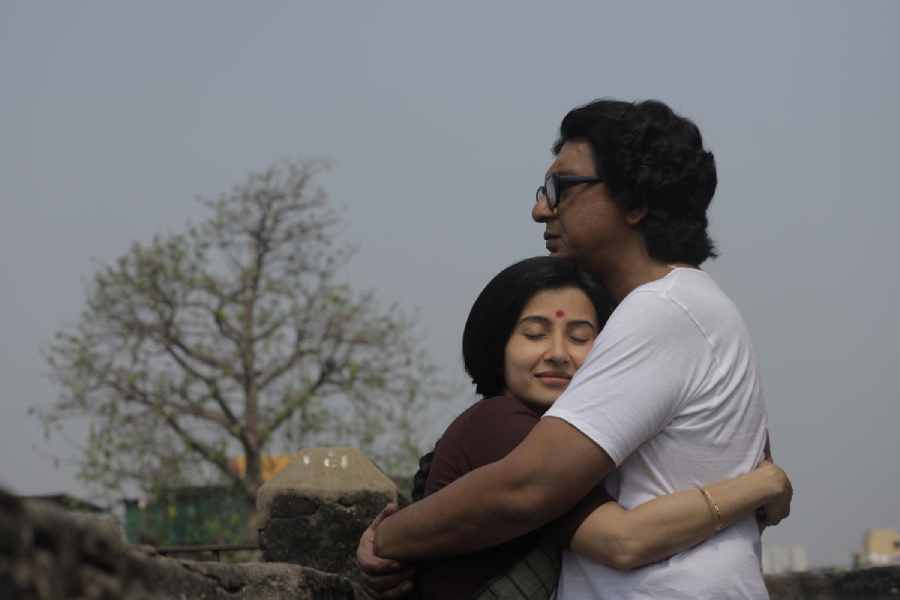Mrinal Sen’s films have always been nothing short of textbooks for me, a student of political cinema. He abhorred nostalgia, his films spoke of the ‘here and now’, and he had always reacted to the politics and events of his time. He was not for the outwardly beautiful, sublimely subtle. His films roared with energy and disturbed us with their rawness. Sen also had the rare courage to evaluate his films objectively, evident in the self-rejection of his debut Raatbhor. Had that not happened, we would not have got a Mrinal Sen.
Watching Padatik (literally translates to the foot soldier) by Srijit Mukherji, I was deeply moved by the love, regard, and passion with which the film was created. Starting with that hat tip to Interview (1971) (in which debutant Ranjit Mallick broke the fourth wall and talked to the camera) was a great idea and had me smiling. As the film progressed, there were numerous instances of more such tools used in the narrative considered hallmarks of Sen’s filmmaking, which many considered ‘gimmicks’ back then. And the way those tools have been used in this complex narrative makes for a rather interesting watch.
Priceless moments
This brings us to another important element — the seamless editing, credited to the director. Here again, one is reminded of the narrative patterns used by the maestro, and Mukherji has followed that pattern and executed it to great effect. Picking moments from Sen’s personal life, his trials and tribulations, and his cinematic journey, he has weaved a screenplay that does justice to the personal and the political and does a good job of merging both.
To that end, quite a few instances are created that stay with you long after the film is over. Sen’s moments with his wife Geeta (also an actor and his comrade), those with his son, his self-effacement and agony juxtaposed with actual footage of his films, the camaraderie he shared with the other master Ray, and that rare scene when Ghatak knocks at Sen’s door, drunk and hungry. There are countless such moments in the film, all priceless.

I particularly enjoyed Sen’s interactions with Ray. The camera looks at them from a respectful distance. Mukherji never takes sides, but accords much dignity and respect to those scenes, given that it is well-known that both the masters were quite critical of each other’s films. That kind of civility and mutual respect despite being critical of each other’s works seems a rarity today. The scene where the Ray-Sen-Ghatak Holy Trinity gets together is worth a million bucks. I am not sure if that is reality or fiction. But it does give you goosebumps and induces a sigh.
Another favourite part of the film is the intercutting of footage from Ray’s Aranyer Dinratri and Sen’s Calcutta ’71, depicting their nature of reactions to political events happening during that time within and outside the boundaries of the country.
A certain calmness
The film traces Sen’s personal life as well. His observations about life, his battle with abject poverty, his struggles with his creativity and craft, his love and marriage, and his fatherhood — all find their rightful places in the screenplay. The writer has dealt with these in chosen bits and pieces. As a sum of its whole, this humanises the master — as only Sen would have wanted — and presents him with a few warts on the mind and soul of that towering persona. The introductory scene of the father and son, the later interactions between them, and the particular scene in which the son reminds the father that geniuses often turn out to be pretty average in other aspects of life felt so relatable. Sen’s relationship with his wife Geeta has been shown with great respect and understanding, and without taking sides or getting overly sentimental. Scenes like the famous kiss on the bridge, the wife waiting for rice while the husband forgets about it and gets busy with his friends, the constant support she lends him when he feels hopeless and is about to quit films, there are moments galore that work so well. And all this is because of deft writing.
Mukherji has used several moments (some real, some imaginary) from Sen’s life to show how they probably made their way into his films. Baishey Sravan (1960) echoes Sen’s witnessing of the personal tragedy of a poor helpless commoner vis-à-vis the national tragedy of the passing of Tagore. This scene also defines the politics of a future filmmaker. Again, in Bhuvan Shome (1969), Utpal Dutt’s journey on a bullock cart is matched with a young Sen having his first experience on a bullock cart.
The film scores brownie points in the technical departments. The cinematography by Indranath Marick adds meaning to the depth intended in the screenplay. The intelligent use of angles and lighting while depicting Ray and Ghatak does a lot in elevating the characters while hiding the obvious dissimilarities between the originals and the actors.
There is also a certain calmness in the frames, compositions, and in the mise-en-scene. This makes the film more sincere in its depiction. The editing, by the director, is top-notch. As a tribute to Sen, he uses several of his techniques like real documentary footage, breaking the fourth wall, freeze frames, jump-cuts, etc. The narrative remains energetic and vibrant at all times.
The art by Tanmoy Chakraborty ably recreates Sen’s homes, the exteriors and the interiors, and the coffee house, while Sabarni Das’s assured costume design transports us to that bygone era seamlessly. The sound design recreates the Calcutta of the yesteryears, the studio interiors, and the like. Indraadip Dasgupta’s background score is another high point of the film. The ace music director has come up with a winner with this one.
Screen on fire
Mukherji must also be commended for the near-perfect casting. Chanchal Chowdhury sets the screen on fire with his performance as the middle-aged and older Sen. So believable he is that one has this uncanny feeling that here is Sen right before you, even though you know it is not true! He has been very well supported by make-up artist Somnath Kundu. The actor makes full use of the rare opportunity of being cast in such an iconic role and delivers and how! One must also mention Jeetu Kamal. He essays the role of Ray, and he has overtaken his performance in a previous film where he had played the maestro. Korak Samanta as the young adult Mrinal Sen is believable and the vulnerability of the character has been well brought out. The scene before the mirror where Sen derides himself is, again, a high point in the film.
Monami Ghosh as Geeta Sen lends a strong shoulder to the film. The director’s wife has always been known to be his true comrade, and the spirit of the character has been well captured by Ghosh. Samrat Chakrabarti as Kunal Sen, the master’s son, looks believable and does a swell job. The rest of the casting has also been thoroughly competent.
On the flip side, if one has to nitpick, the make-up depicting Mrinal Sen in his last few years leaves room for betterment. Also, his wife had acted in a few films of his. It would have been great if those were included. The AI use of Ray’s voice wasn’t working for me. Maybe a couple more issues, but these are hardly anything to spoil the show in this heartfelt tribute mounted and executed with sincerity, with the deepest respect for the master.
There are films that you watch to learn about legends when you’re accustomed to their work. Then there are films that you watch cold and uninitiated, and then get enthused to delve into the life and work of that legend. Padatik belongs a bit to both. It works for all Mrinal Sen’s admirers, as well as a film which will enthuse more people to get to know his life and works. Kudos to Mukherji for having achieved this feat.
While watching this biopic, I also felt it could also be read as Mrinal Sen’s Bildungsroman — the story of a passionate young adult who grows into a world-weary philosopher (who never considered himself old), the story of a lover who is so accustomed to his wife being beside him all the time that he keeps forgetting she is no more, the story of a father who is protective of his son during an earthquake to being lent a helping hand in his twilight years. And, more importantly, the story of the maker of Raatbhor transformed into the director who gave rise to the Indian New Wave.
In the present dark times when the film has been released in the theatres, one is almost certain that Sen would have reacted cinematically to the happenings around us. In the end, as the protest marches on the highway have passed and the last shot has been canned, he would sit on the road in his signature pose, turn, and say, “Cut!”










